Research Community Engagement Survey Summary: Institute of Human Development, Child & Youth Health (IHDCYH)
Table of contents
- Introduction
- Executive Summary
- Respondent Demographics
- Partnering, Collaborating, & Convening
- Catalyzing Research
- Knowledge Creation
- Knowledge Mobilization (KM)
- Capacity Building and Career Pathways
- Pandemic Impacts and Recovery
- Recurring Themes
- Methods
Introduction
We are committed to engaging with our community, including early career researchers, mid-career researchers, senior career researchers, clinician-scientists, trainees and fellows, as well as knowledge users – to identify strategic directions and research priorities that will make a difference. Between September 2020 and March 2021, IHDCYH as a founding partner of Inspiring Healthy Futures engaged broadly with a diversity of youth, parents, services providers, youth-serving agencies, cross-sector experts, and others to develop a commitment and action framework to mobilize communities around children, youth, and families in Canada. The IHDCYH community survey was launched to build on that work to deepen our understanding of the perspectives and needs of researchers.
In Fall 2021, we asked researchers to share their perspectives on challenges they face, opportunities to leverage strengths, the aspects of IHDCYH-led funding programs that are working well, and ideas on how we can continue to enhance the way we support the IHDCYH community.
This report summarizes the key findings from our Institute’s community engagement survey. It serves as a vital piece to our strategic planning process.
Executive Summary
As a part of IHDCYH’s strategic planning process, in Fall 2021 we launched a survey intended as a deeper dive with researchers following our engagements with the broader research community with Inspiring Healthy Futures. We wanted to hear more about researchers’ perspectives on challenges, opportunities, the types of IHDCYH-led funding programs and activities that are working well, and ideas on how we can continue enhancing the way we support the IHDCYH community. The valuable information from the 220 responses we received is actively shaping the future of our Institute activities and funding priorities.
-
Respondent Demographics
We heard from researchers at all career stages, clinician-scientists, trainees and fellows, and knowledge users. Overall, there were responses from diverse community members, including 27% identifying as South Asian, Jewish, East Asian, Middle Eastern, Latin American, Black, or Southeast Asian collectively. In total, 20% of respondents identified as having a disability. However, fewer than 2% of respondents identified as indigenous; as transgender, non-binary, or two-spirit; and as having a visible disability respectively.There is therefore a clear need to continue our efforts to enhance representation in all engagements that we do.
-
Partnering, Collaborating, & Convening: (including “Interdisciplinary Team Research”)
Over 40% of respondents did not feel well connected to partners, including significant challenges or barriers to initiating and sustaining partnerships with knowledge users. On the other hand, the majority of respondents generally felt actively engaged in interdisciplinary teams. Research funding, opportunities for networking, and recognition of interdisciplinary research by academic institutions were some of the top mechanisms identified for developing and maintaining interdisciplinary teams. -
Catalyzing Research
Respondents felt that strategic funding, supports in grantsmanship, support for building interdisciplinary teams, mock peer review, and mentorship effectively catalyze success. -
Knowledge Creation
Over 90% of respondents agreed that taking a lifecycle perspective enhances research. New and emerging research directions covered critical aspects of health, well-being, fulfillment, and engagement in life. -
Knowledge Mobilization (KM)
Most respondents had some degree of comfort in developing end of grant and integrated knowledge mobilization (KM) approaches. Training in integrated KM, specific funding for KM, supports to connect with knowledge users, and implementation science training were requested. -
Capacity Building and Career Pathways
For academic careers, funding, mentorship, and protected time for research were factors that often support respondents’ careers. There was interest in training in areas such as grantsmanship, research group management, grant administration, and networking. However, more than half of respondents are considering careers outside of academia, such as health policy or industry. -
Pandemic Impacts and Recovery
The pandemic at least moderately negatively impacted most respondents, and many are managing caregiving responsibilities. Measures to support funding use and attainment had been helpful. -
Additional Recurring Themes
Sustainable funding, peer review, networking and partnerships, child and youth data, transition to early career research, mental health and work/life balance and; equity, diversity, and inclusion in research and for researchers recur as themes throughout this report.
Respondent Demographics
220 Total respondents
This summary reports percentages based on the number of responses per question, which varies.
Career stage or Role (n=219)
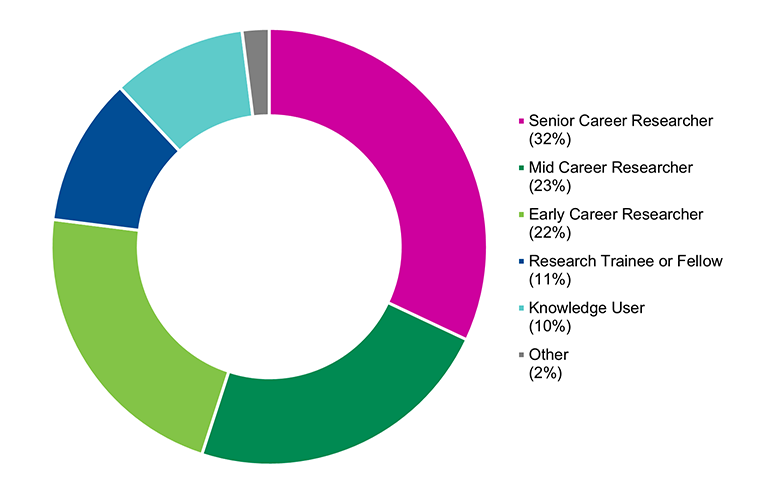
-
Figure 1 Long Description
Response count Percentage Senior Career Researcher 69 32% Mid Career Researcher 50 23% Early Career Researcher 48 22% Research Trainee or Fellow 24 11% Knowledge User 21 10% Other 5 2%
CIHR Pillar (n=219)
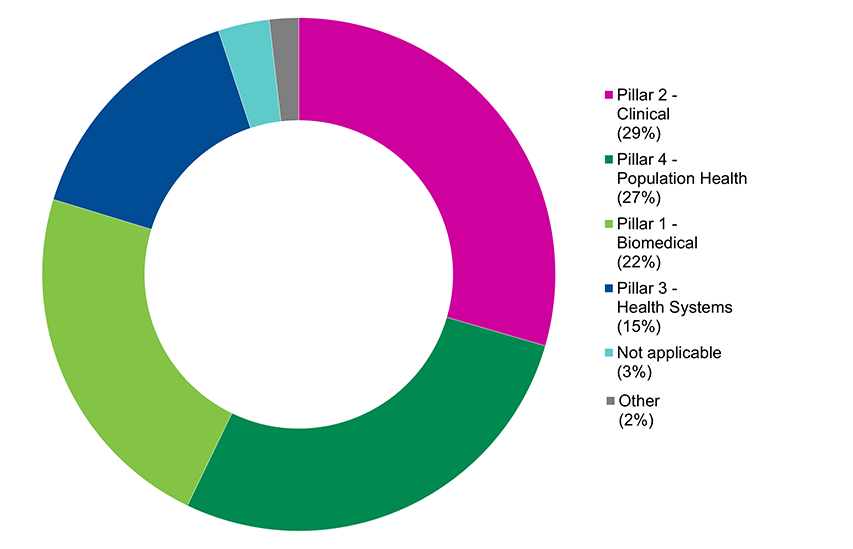
-
Figure 2 Long Description
Response count Percentage Pillar 2 - Clinical 64 29% Pillar 4 - Population Health 60 27% Pillar 1 - Biomedical 49 22% Pillar 3 - Health Systems 33 15% Not applicable 7 3% Other 4 2%
Location (n=209)
| Ontario | 42% |
| British Columbia | 14% |
| Quebec | 14% |
| Alberta | 12% |
| Manitoba | 6% |
| Nova Scotia | 5% |
| Prefer not to answer | 3% |
| Outside of Canada | 1% |
| Saskatchewan | 1% |
| New Brunswick | 0.5% |
| Yukon | 0.5% |
| Prince Edward Island | 0.5% |
| Northwest Territories, Nunavut, Newfoundland and Labrador | 0% |
Characteristics and Intersectionality
| 81% of respondents identify as White Canadian, White American, or White European; while 27% identify as South Asian, Jewish, East Asian, Middle Eastern, Latin American, Black, Southeast Asian collectively |
| About 16% of respondents identify with having a disability, of which 15% of respondents identify as having an invisible disability |
| <2% of respondents identify as transgender, non-binary, or two-spirit |
| <2% of respondents identify as Indigenous |
Partnering, Collaborating, & Convening
Partnerships: Current state
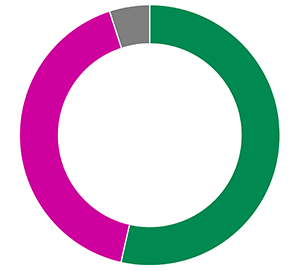
- 41%
- Disagree to some extent
- 53%
- Agree to some extent
“I feel well connected with partners who are able to provide financial or in-kind support for elements of my research activities.” (n=215)
41%
Have aspects of their research program supported by partners financially (n=205)
61%
Have aspects of their research program supported by partners in-kind (n=205)
“Which, if any, aspects of your research program are supported by partners – either through in-kind or financial support?” (n=205) (Top 8 responses shown)
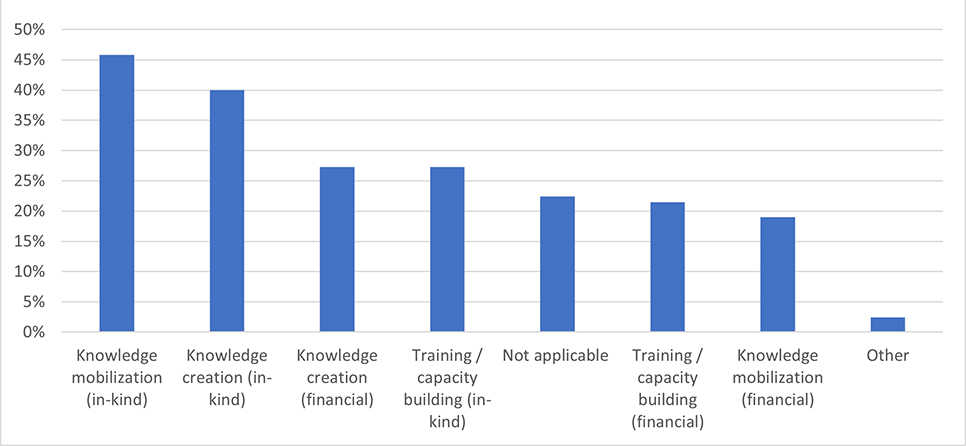
-
Figure 4 Long Description
Response count Percentage Knowledge mobilization (in-kind) 94 46% Knowledge creation (in-kind) 82 40% Knowledge creation (financial) 56 27% Training / capacity building (in-kind) 56 27% Not applicable 46 22% Training / capacity building (financial) 44 21% Knowledge mobilization (financial) 39 19% Other 5 2%
What we’ve heard about partnership needs
Researchers face both individual level and systemic barriers to identifying, initiating, and sustaining partnerships with knowledge users. Supports are needed to meaningfully engage with underserved and racialized communities as well as with decision makers, clinicians, providers, patients, and clients within healthcare, social services, and public health sectors. Training, direct support, and funding for partnerships are in high demand.
Interdisciplinary teams: Current state
90%
Agree to at least some extent
“I am actively engaged in an interdisciplinary research team.” (n=218)
Supports and needs for building and sustaining interdisciplinary teams
Which funding types have you found most effectively support the development and activities of interdisciplinary teams?” (n=212) (Top 6 responses shown)
| Operating grant funding | 42% |
| Investigator-initiated competitions | 42% |
| Team grant funding | 42% |
| Catalyst grants | 24% |
| Knowledge mobilization grants | 22% |
| Planning grants | 20% |
“What do you identify as your key non-funding needs as you establish and/or build an interdisciplinary collaborator network?” (n=211) (Top 6 responses shown)
| Opportunities for networking | 52% |
| Recognition of interdisciplinary research by […] academic institutions | 48% |
| Resources and information to help identify potential collaborations | 40% |
| Training in skills / approaches to interdisciplinary research | 38% |
| Trainees equipped with skills / expertise to interdisciplinary research | 36% |
| Common understanding of what constitutes interdisciplinary research | 32% |
What we’ve heard about interdisciplinary research team needs and experiences
Researchers appreciate that significant time and interpersonal skills are needed to build relationships, create common goals, and sustain an interdisciplinary team. Challenges to developing these teams include navigating the research expectations of different fields and institutions (e.g., timelines, indicators of success and productivity, priorities); securing funds to support team operations, allocating enough time to build and sustain teams, initiating teams, geographic separation, working through team logistics (e.g., workload, communication practices, roles), and overcoming differences in terminology and paradigms.
There was concern about misalignment between current grant processes and interdisciplinary research, for example time required to develop collaboration and peer review panel composition. Potential disconnect was highlighted between the requirement to designate a Nominated Principal Applicant and the ethos of interdisciplinary teams, including fair recognition and distribution of funds.
Catalyzing Research
Success facilitators for CIHR investigator-initiated (Project Grant) competitions
“What factors do you think facilitate success in the CIHR investigator-initiated competitions?” (n=206) (Top 4 responses shown)
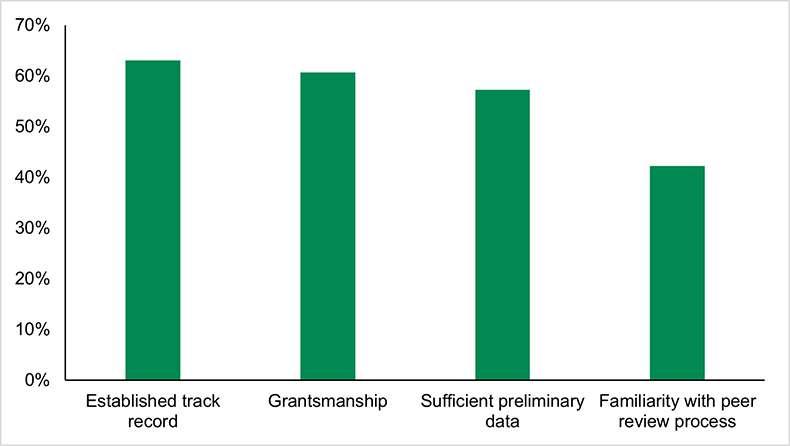
-
Figure 5 Long Description
Response count Percentage Established track record 130 63% Grantsmanship 125 61% Sufficient preliminary data 118 57% Familiarity with peer review process 87 42%
“Which strategic funding types do you think most effectively lead to success in the CIHR investigator-initiated competitions?” (n=196) (Top 3 responses shown)
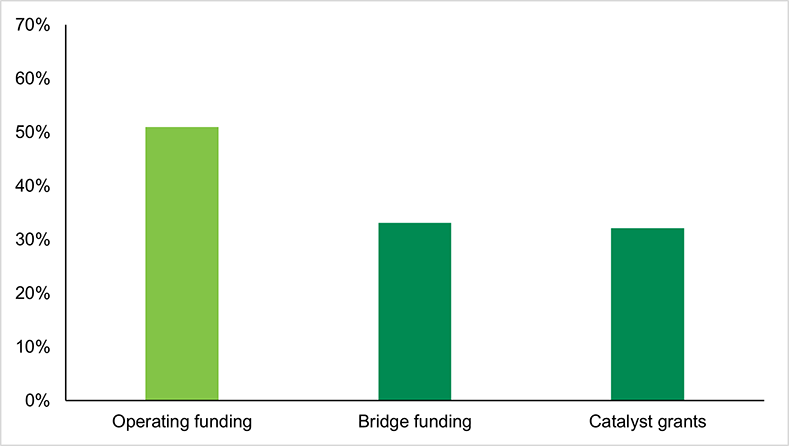
-
Figure 6 Long Description
Response count Percentage Operating funding 100 51% Bridge funding 65 33% Catalyst grants 63 32%
“Which non-funding supports do you consider most effectively catalyze success in the CIHR investigator-initiated competitions?” (n=195) (Top 6 responses shown)
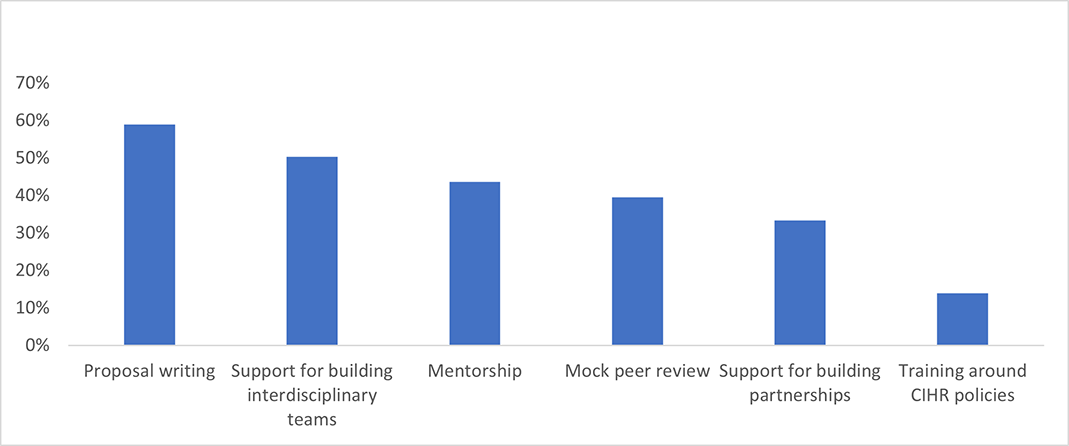
-
Figure 7 Long Description
Response count Percentage Proposal writing 115 59% Support for building interdisciplinary teams 98 50% Mentorship 85 44% Mock peer review 77 39% Support for building partnerships 65 33% Training around CIHR policies 27 14%
Knowledge Creation
Endorsing strategic directions

- 91%
- Agree to at least some extent
“Taking a lifecycle perspective enhances research” (n=193)
What we’ve heard about the lifecycle approach
Overall, respondents were supportive of a lifecycle approach to health research and felt that IHDCYH was well positioned to lead this work. Some emphasize the need for more funding and infrastructure to support lifecycle research, while others highlighted the need to ensure that critical life stages such as pregnancy, early childhood and adolescence are prioritized in research, funding, and peer review. There was some concern that a focus on the lifecycle may lead to underrepresentation of the early years and decreased focus on non-lifecycle related research.
New and emerging research directions of interest and need
- Social determinants of health
- Health geography and societal stress
- Relationships between health, exercise, and outdoor play
- Early child development
- Implementation science
- Digital health and technology-enabled research and intervention
- Supports for children with disability and chronic health conditions
- Equity, diversity, and inclusion
Knowledge Mobilization (KM)
Perspectives on capability in knowledge mobilization
79%
Agree to at least some extent
“I am comfortable developing end of grant KM activities” (n=202)
75%
Agree to at least some extent
“I am comfortable developing an integrated KM approach” (n=200)
73%
Agree to at least some extent
“I am confident that I am engaging knowledge users in a manner that […] is of most use to them” (n=201)
Hopes for knowledge mobilization supports
“How can IHDCYH best support you to enhance both end of grant and integrated knowledge mobilization as part of your research program?” (n=192) (Top 8 responses shown)
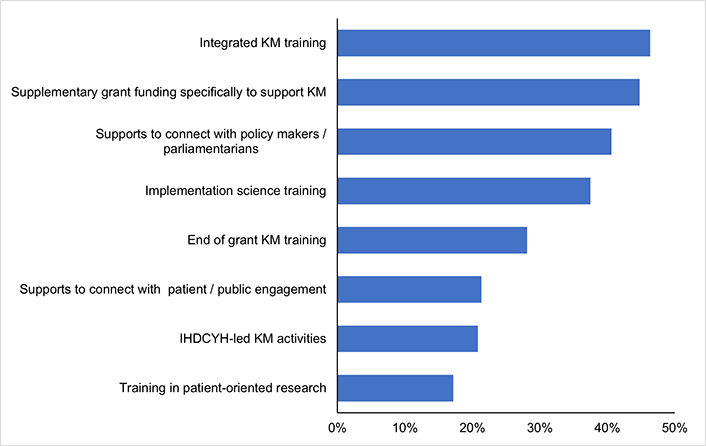
-
Figure 9 Long Description
Response count Percentage Integrated KM training 89 46% Supplementary grant funding specifically to support KM 86 45% Supports to connect with policy makers / parliamentarians 78 41% Implementation science training 72 38% End of grant KM training 54 28% Supports to connect with patient / public engagement 41 21% IHDCYH-led KM activities 40 21% Training in patient-oriented research 33 17%
What we’ve heard about knowledge mobilization needs
There is a need for training in both the theory and practice of knowledge mobilization, as well as for supplementary grant funding. Researchers want to effectively engage with knowledge users such as policy makers and patients using evidence-based strategies, but face barriers. Researchers want to see greater capacity in implementation science.
Current knowledge user landscape
“Which knowledge user group(s) do you engage with regularly?” (n=199) (Top 10 responses shown)
59%
Healthcare staff or administrator
58%
Parent, family, or caregiver
51%
Patient or person with lived experience
50%
Professional organization
42%
Members of the public
40%
Community organizations
36%
Youth
36%
NGO or charity
31%
Policy maker (e.g., federal)
12%
Business or industry
Capacity Building and Career Pathways
Facilitating factors: Career development
“What support has been most impactful in your career so far?” (n=215) (Top 8 responses shown)

-
Figure 10 Long Description
Response count Percentage Funding 174 81% Mentorship from a senior colleague 128 60% Protected time for research 122 57% Supportive institutional environment 85 40% Networking 49 23% Peer-to-peer mentorship 42 20% Opportunity to supervise trainees 41 19% Training in research-related skills 33 15%
Facilitating factors: Training and support
“Which training or supports has been or could be useful to your career?” (n=212) (Top 13 responses shown)
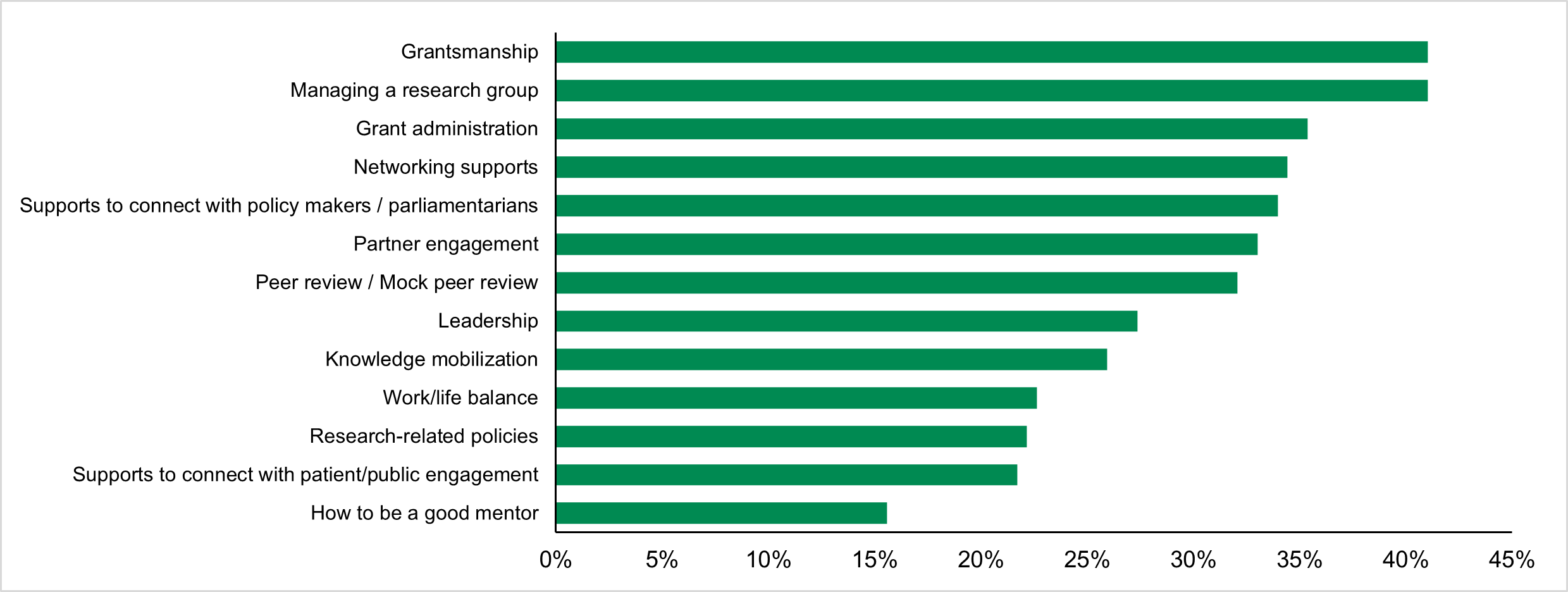
-
Figure 11 Long Description
Response count Percentage Grantsmanship 87 41% Managing a research group 87 41% Grant administration 75 35% Networking supports 73 34% Supports to connect with policy makers / parliamentarians 72 34% Partner engagement 70 33% Peer review / Mock peer review 68 32% Leadership 58 27% Knowledge mobilization 55 26% Work/life balance 48 23% Research-related policies 47 22% Supports to connect with patient/public engagement 46 22% How to be a good mentor 33 16%
What we’ve heard about career pathway and capacity building needs
Researchers face challenges in finding positions in academia, continuity of funding to establish or maintain their programs, including stable employment for research staff, achieving work-life balance, and navigating research ecosystem concerns including research competitiveness and how research agendas are set. Some researchers in the community also experience challenges to research and/or career advancement due to discrimination and other systemic barriers. Clinician-Scientists and Early Career Researchers are hoping for more opportunities and support specific to their career stage and professional context. Mid Career Researchers face distinctive challenges in sustainable funding. Some Senior Career Researchers grapple with retirement. Particular emphasis was placed on ensuring that both the needs and trust with Indigenous people are addressed.
Researcher movement and expansion to non-academic positions
“If you are considering alternatives to academic research pathways, which of the following is most interesting to you?” (n=184)
55%Are interested in careers outside of academia |
Here is a breakdown of the sectors these researchers are considering: | |||
51%Health policy |
30%Industry |
26%Research administration |
12%Other (e.g., Clinical) |
|
Pandemic Impacts and Recovery
Pandemic impacts
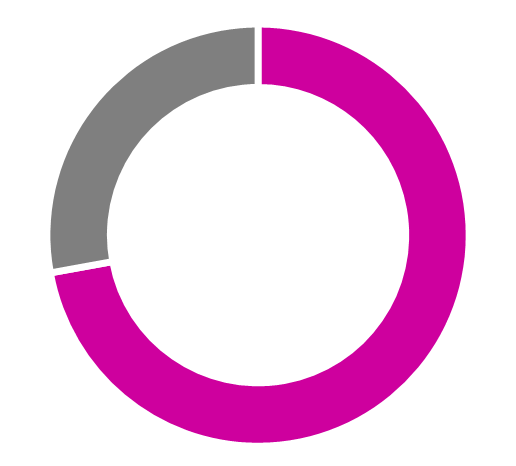
- 72%
- Feel at least moderately negatively impacted by the pandemic (n=201)
Caregiving responsibilities
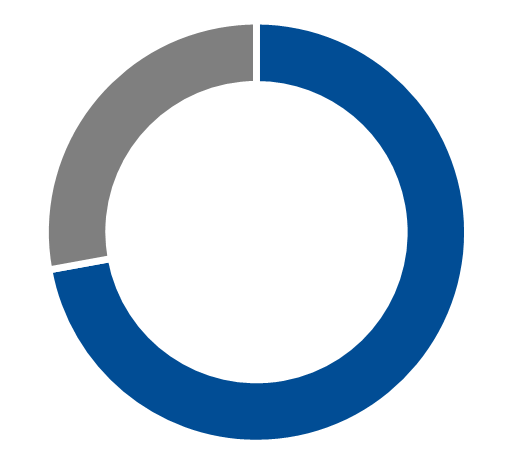
- 61%
- Have caregiving responsibilities (n=188)
Mitigating strategies
“Which, if any, of the measures that have been put in place to support the research community have you or your team benefitted from and/or perceive as helpful?” (n=168)
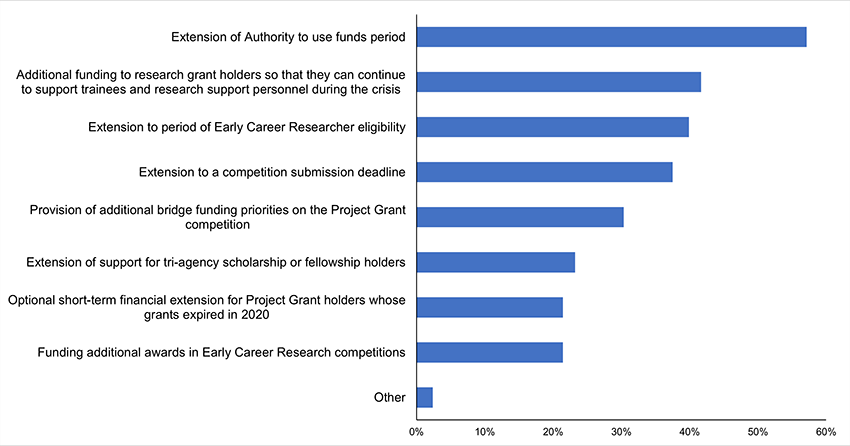
-
Figure 14 Long Description
Response count Percentage Extension of Authority to use funds period 96 57% Additional funding to research grant holders so that they can continue to support trainees and research support personnel during the crisis 70 42% Extension to a competition submission deadline 63 38% Provision of additional bridge funding priorities on the Project Grant competition 51 30% Extension of support for tri-agency scholarship or fellowship holders 39 23% Optional short-term financial extension for Project Grant holders whose grants expired in 2020 36 21% Funding additional awards in Early Career Research competitions 36 21% Other 4 2%
Recurring Themes
We identified recurring themes that interact, intersect, and influence in different ways within and throughout the different sections of this report.
- Sustainable funding
- Networking and partnerships
- Child and youth data
- Mental health and work/life balance
- Peer review
- Transition to Early Career Research
- Equity, diversity, and inclusion in research and for researchers
who are women, have a disability, are racialized, Indigenous, and are from the LGBTQ+ community.
Methods
Between September 2020 and March 2021, IHDCYH as a founding partner of Inspiring Healthy Futures engaged broadly with a diversity of youth, parents, services providers, youth-serving agencies, cross-sector experts, and others to develop a commitment and action framework to mobilize communities around children, youth, and families in Canada. Following these broader conversations, we launched a survey targeted at researchers to learn more about their perspectives.
The IHDCYH community survey was developed, and pilot tested over the Summer and early Fall of 2021.We received valuable feedback on survey design from Institute advisory members, early career researchers, and trainees to improve clarity, length, and ease of use. It contained 48 questions, with a mix of both closed-ended and open-ended questions.
The survey launched in Fall 2021 for a 6-week period. We disseminated the survey through a broad variety of channels including IHDCYH’s and CIHR’s social media (Twitter and LinkedIn), IHDCYH’s newsletter and website, and partner email lists (e.g., research institute leadership, pediatric healthcare centres). The survey was available in both French and English.
The IHDCYH team used descriptive statistics to summarize the quantitative data collected. Qualitative information was themed and narratively summarized.
- Date modified: